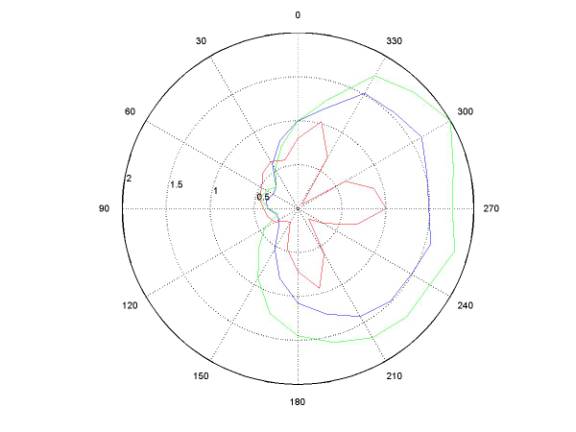High Performance Directional Microphones for Hearing Aids
Douglas L. Jones - dl-jones@uiuc.edu
Christopher D. Schmitz
Nandini Iyer
Michael E. Lockwood
Charissa R. Lansing
Albert S. Feng
Dept. of Elec. and Computer Eng.
Univ. of Illinois at Urbana-Champaign
1406 W. Green St.
Urbana, IL 61801
Popular version of paper 5aPPa4. Improved BTE hearing-aid directivity using a directional microphone array.
Presented Friday morning, May 28, 2004
147th ASA Meeting, New York, NY
Introduction
Hearing loss affects more than 20 million Americans, making it one of the most common disabilities nationwide. While hearing aids can help, a great many users still find hearing a single conversation in noisy surroundings, such as restaurants and parties, almost impossible. One promising solution is the use of directional microphones. Just as the beam of a spotlight penetrates the darkness to reveal a single actor on stage, a directional microphone focuses incoming sound from a particular direction. Sound arriving from the direction to which the "beam" is pointed (usually the direction in which the listener is facing) is enhanced while sound that arrives from other directions is not, thus improving the directional sensitivity or "directivity" of the microphones. A new microphone system achieves better directivity than standard hearing aids even under the varied conditions encountered in normal use.
Common Methods of Hearing Enhancement
Hearing aid manufacturers typically improve microphone directivity in one of two ways. The first strategy uses a single microphone with two openings (pressure-gradient microphones) designed to enhance sounds coming from a particular direction. The second strategy is to electronically combine the outputs of two separate microphones, to get the same effect as with the two openings. Each approach has advantages and disadvantages. In laboratory situations, hearing aids with these simple directional microphones improve directivity gains by factors of two to four (or 3-6 dB ("deciBels")), greatly improving speech intelligibility in noisy surroundings.
By combining the outputs of even more microphones, further improvements are in principle possible. However, practical issues have largely confined three-microphone systems to the laboratory. A standard multi-microphone system works well only when the microphones are exquisitely matched; even a few percent difference in the volume level from each microphone (such as naturally occurs due to changes in temperature, humidity, or accumulation of dirt or ear wax) can wipe out most of the directivity benefit. A pressure-gradient microphone shares the same hardware between the two openings, and is therefore always naturally matched. However, it is limited to two openings and it cannot be adjusted to the head's effects on the incoming sounds.
Proposed Improvement in Hearing Devices
We have developed a three-microphone system that uses both omnidirectional and gradient microphones. It takes advantage of the benefits of each microphone type, and of the sound field near the head, to achieve better directivity than current directional microphones. The system has two microphones that are equally sensitive to sounds arriving in all directions (omni-directional microphones) and one pressure-gradient microphone - we call this the "o-g-o array." Our preliminary tests show similar benefit in directivity to a three-omni-directional (o-o-o) microphone hearing aid (similar to the state-of-the-art Siemens' Triano which was recently released), and almost 2 dB better than two-microphone or pressure-gradient devices. Most importantly for practical hearing aids, the new system is very tolerant to changes in the microphone gains that might be experienced in normal use, so the full directivity gains of a three-microphone system may ultimately be achievable in hearing aids available to the consumer.
The individual pattern of each microphone (when placed on the right-hand-side
of the head) is shown from above in Fig. 1, and the optimal beampattern from
combining the microphones is shown in Fig. 2 (in both figures, the direction
of interest is at 0 degrees). Both arrays provide over 6 dB directivity gain1
over omni-directional microphones - in other words, in situations when the signal
and noise are equally intense using an omni-directional microphone
(click here to hear an omni example) , the three-microphone array enhances
the power of the signal of interest by four times at the listener's ear
(click here to hear an o-g-o example) . Since reduction of performance over
time is a major concern in hearing-aid microphones, simulations were conducted
to see how the directivity changes as the microphones become mismatched. In
these tests, we randomly varied the gains of each microphone independently by
standard deviations of 1, 5, or 10%. Fig. 3 shows that while both three-microphone
systems provide equivalent gains in directivity with matched microphones, the
o-g-o device continues to work well with microphone mismatches. On the other
hand, for comparable microphone mismatches, the three-omni-microphone device
loses most of its gain.

Figure 1. Original patterns of two omnidirectional microphones and
one gradient microphone when placed on the right-hand-side of the head at 1
kHz.

Figure 2. Optimal combined response of three microphones of Fig.1
at 1 kHz.

Figure 3. Array performance averaged over 50 independent trials
of random microphone gain variation.
Conclusion
Arrays of three microphones have significant potential benefits for hearing aid users. However, for arrays consisting purely of omni-directional microphones, mismatch in individual microphone gains due to age and environment may nullify the benefit of the extra microphones. The exchange of a pressure-gradient microphone for one of the omni-directional microphones creates a device remarkably resistant to these degradations.
1. The directivity is weighted in frequency using the articulation index...a method designed to match the typical performance of humans trying to understand speech in noise.
This work was partially supported by NIH (NIDCD) under grant no. 1 R01 DC005762-01A1.


